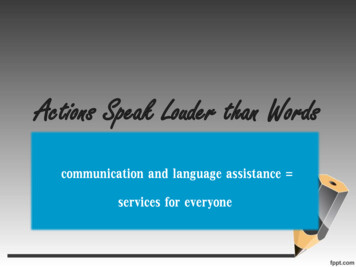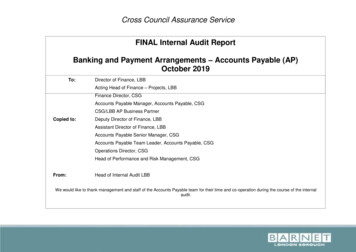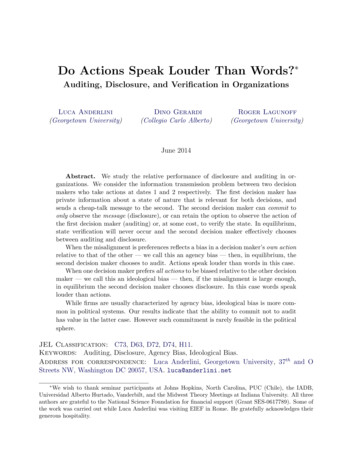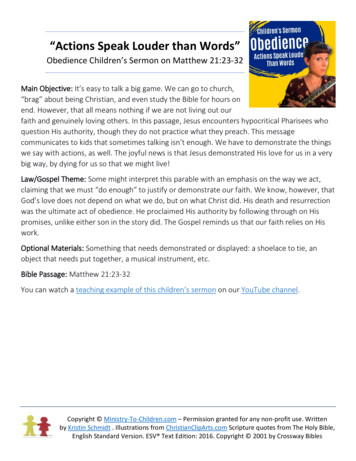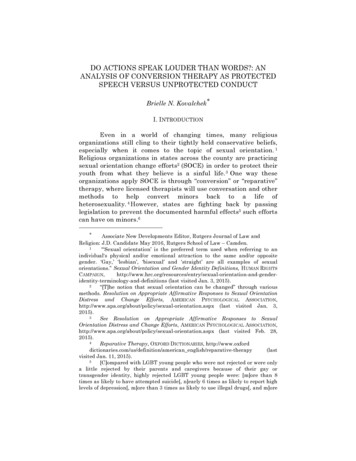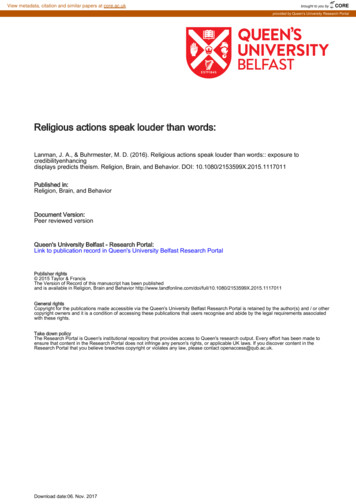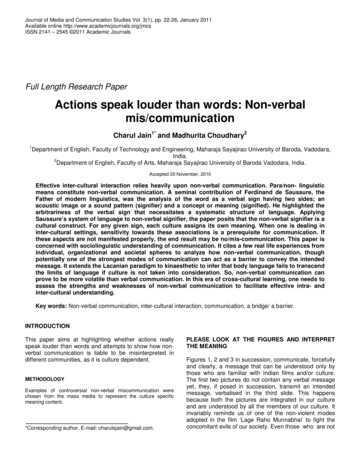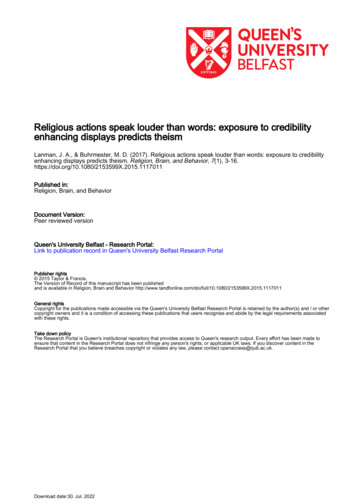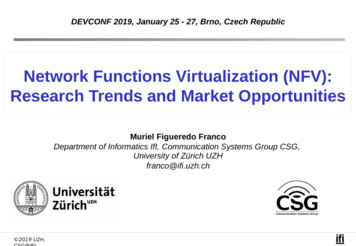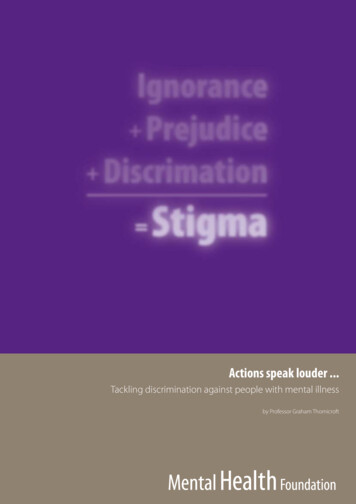
Transcription
Actions speak louder .Tackling discrimination against people with mental illnessby Professor Graham Thornicroft
All material Graham Thornicroft, 2006NOTE: Parts of this report are reproduced with the permission of Oxford University Pressfrom ‘Shunned: Discrimination against People with Mental Illness’ by Graham Thornicroft (OUP, 2006)
CONTENTSi)ii)Foreword by Dr Andrew McCullochExecutive Summary341Introduction: from Stigma to Ignorance, Prejudice and Discrimination102The Experience of Stigma and Discrimination112.12.22.3Stigma and discrimination at homeStigma and discrimination in personal and intimate relationshipsStigma and discrimination at work1213153Understanding Stigma183.13.2Shortcomings of stigma modelsThree core problems18194Agenda for Policy Makers254.14.24.34.4The policy frameworkPolicy action needed to support individuals and their familiesPolicy action needed at the local levelPolicy action needed at the national level252631375Conclusion: Demolishing Structural Discrimination486Acknowledgements507Appendix 1. Internet Resources518Appendix 2. UK Disability Discrimination Act 1995539Appendix 3. Key International Declarations & Covenants on Human Rights5510References59Actions speak louder .
stigma projects thefear and anxiety feltby members of thegeneral population ontothe person with thediagnosis. Peoplewith a diagnosis do notreally carry a mark thatsets them aside. Actions speak louder .
ForewordPeople with direct experience of mental health problems - as service users, carers or professionals - have longbeen aware of the impact of discrimination against people with psychiatric diagnoses. Over recent decadesresearch by organisations like the Mental Health Foundation has confirmed that discrimination has a huge impacton people’s lives.However, as a sector we have not always been clear about how discrimination works or how it can be tackled, orof the relationship between discrimination, stigma and ignorance. I have long disliked the term “stigma” becauseit projects the fear and anxiety felt by members of the general population onto the person with the diagnosis.People with a diagnosis do not really carry a mark that sets them aside. As a society we have spent many millionsof pounds trying to tackle stigma and discrimination without a clear model of how change can be achieved. Yetdespite all our efforts and all the services we deploy, outcomes for severe mental illness in Western society remainworse than in some developing countries.I believe this report, which represents an exciting collaboration between the researcher and author, ProfessorGraham Thornicroft, and the Foundation, represents a major step forward in our thinking. It throws the real livedexperience of service users, who have told Graham their stories, into sharp perspective.The report pulls together a mass of evidence from across the world and highlights the impact that discriminationhas. It takes a hard nosed view of the evidence and once again underlines the importance of an experientialapproach where direct contact with service users is the catalyst for attitude change. It sets out a policy agenda forchange based on key principles including user involvement, collecting and using evidence, and building a robustchange model. The Mental Health Foundation is working to build capacity and support the development of userled initiatives across the UK in order to support the fight against discrimination which needs to be comprehensiveand inter-sectoral.I found this report both moving and stimulating – it appeals to both our heads and our hearts. I hope you too willfind it a stimulus to action and to real change for some of the most marginalised people in our society.Dr Andrew McCullochChief ExecutiveMental Health FoundationActions speak louder .
Executive SummaryIntroductionIt is now beyond doubt that widespread discrimination adds to the disability of people with mental illness. Thebasic problem is this: many people with mental illness are subjected to systematic disadvantages in most areas oftheir lives. These forms of social exclusion occur at home, at work, in personal life, in social activities, in healthcare,and in the media.This hard-hitting Mental Health Foundation policy paper both analyses these forms of social exclusion and sets aclear agenda for what policy makers need to do to tackle head-on such discrimination and social inequality. Thefocus here is upon policy change, based upon a thorough review of all the relevant evidence, and perhaps moreimportantly, from listening to the voices and views of people with mental illnesses who describe their experiencesin their own words.From Stigma to Ignorance, Prejudice and DiscriminationThe concept of stigma is necessary to develop an understanding of experiences of social exclusion, but it isnot sufficient to grasp the whole picture, nor to know what practical steps need to be taken to promote socialinclusion. Stigma is best seen as three related problems:Ignorance: strong evidence is presented here that most people have little knowledge about mental illnesses,and much of this information is factually incorrect. There is a pressing need to convey more useful information,for example about how to recognise the features of mental illness and where to get help, both to the wholepopulation and to specific groups such as teenagers.Prejudice: fear, anxiety and avoidance are common feelings both for people who do not have mentalillness (when reacting to those who have), and for people with mental illness who anticipate rejection anddiscrimination and therefore impose upon themselves a form of ‘self-stigma’ or internalised stigma.Discrimination: the scientific evidence and the strong message from service users and their advocates are clearthat discrimination blights life for many people with mental illness, making marriage, childcare, work, and anormal social life much more difficult. Actions are needed to specifically redress the social exclusion of peoplewith mental illness, and to use the legal measures intended to support all disabled people (such as the DisabilityDiscrimination Act) for physical and mental disabilities on the basis of parity. Actions speak louder .
Executive SummaryAction to support service user advocacy groupsEmpowerment has been described as the opposite of self-stigmatisation. Policy makers should therefore providespecific financial support for ways in which individuals with mental illness can empower themselves or beempowered including the following: Participating in formulating care plans and crisis plansUsing Cognitive Behavioural Therapy to reverse negative self-stigmaRunning regular assessments of consumer satisfaction with servicesCreating user-led and user-run servicesDeveloping peer support worker roles in mainstream mental health careAdvocating for employers to give positive credit for experience of mental health illnessTaking part in treatment and service evaluation and researchAction to support individuals and their familiesA series of changes are necessary to assist individual people with mental illness and their carers and familymembers:ActionByDevelop new ways to offer diagnosesMental health staffHave information packages for family members thatexplain causes, nature and treatments of differenttypes of mental illnessMental health staff, service users and familiesActively provide factual information against popularmythsMental health staffDevelop and rehearse accounts of mental illnessexperiences which do not alienate other peopleMental health staff and service user groupsActions speak louder .
Executive SummaryAction to support people with mental illness at workFor some people with mental illness, allowance needs to be made at work for their personal requirements. Inparallel with the modifications made for people with physical disabilities, people with mental illness-relateddisabilities may need what are called ‘reasonable adjustments’ in the Disability Discrimination Act. In practice thiscan include the following measures: for people with concentration problems, having a quieter work place with fewer distractions rather thana noisy open plan office, with a rest area for breaks more, or more frequent, supervision than usual to give feedback and guidance on job performanceallowing a person to use headphones to block out distracting noisefl exibility in work hours so that they can attend their healthcare appointments, or work when notimpaired by medication roviding an external job coach for counselling and support, and to mediate between employee andpemployer buddy/mentor scheme to provide on-site orientation, and assistancec lear person specifications, job descriptions and task assignments to assist people who find ambiguity oruncertainty hard to cope with f or people likely to become unwell for prolonged periods it may be necessary to make contractmodifications to specifically allow whatever sickness leave they need a more gradual induction phase, for example with more time to complete tasks, for those who return towork after a prolonged absence, or who may have some cognitive impairment improved disability awareness in the workplace to reduce stigma and to underpin all otheraccommodations reallocation of marginal job functions which are disturbing to an individualallowing use of accrued paid and unpaid leave for periods of illnessActions speak louder .
Executive SummaryAction needed at the local levelIn local communities or health and social care economies the following initiatives are needed to promote thesocial inclusion of people with mental illness:ActionByCommission and provide supported work schemesin line with the Social Exclusion Unit’s recommendedaction. Develop new ways to offer diagnoses.Commissioners and mental health services, includingnon-statutory sector providersIncrease the availability of psychological treatments to Primary health services and secondary mental healthimprove cognition, self-esteem, confidence and social servicesfunctioning.Health and social care employers give recognition tothe ‘expertise by experience’ of people with a historyof mental illness through positive encouragementand support in recruitment and staff managementpractices.Health and social care agencies in both the statutoryand non-statutory sectorsEnsure people with mental illness and employers are Mental health services, employers and businessproperly informed of their rights and obligations under confederations, law organisations, CABx and otherthe Disability Discrimination Act, including changesadvice agenciesthat are coming into effect.Mental health agencies and advice organisationsactively encourage and support service users insecuring their rights under the Act.Mental health services, employers and businessconfederations, law organisations, CABx and otheradvice agenciesMore widespread implementation, evaluation, andEducational organisations, police, healthimpact assessments of focused anti-discriminationcommissioning and providing organisations, researchinterventions (including those that are part of SHIFT) organisationswith particular groups including school children, policeand healthcare staff.Provide accurate data on mental illness recovery rates Professional training and accreditation organisations,to mental health practitioners and to service users and mental health service providerscarers.Encourage and support greater service userinvolvement in local speakers’ bureaux and otheranti-sigma and anti-discrimination initiatives.SHIFT, service user organisationsEnsure local implementation of CPA includes careplans that are properly negotiated between staff andservice users.Mental health services, Commissioners, HealthcareCommissionActions speak louder .
Executive SummaryAction needed at the national levelIn terms of national policy, a series of changes are necessary which span governmental ministries, the nongovernmental and independent sector, along with service user and professional groups. This is a vision of a longterm attack upon individual and systemic discrimination through a co-ordinated, multi-sectoral programme ofaction to promote the social inclusion of people with mental illness.ActionByPromote a social model of disability that incorporatesmental health problems (including those of atemporary nature) within the mental health sector,which refers to human rights, social inclusion andcitizenship.NIMHE, mental health service commissioners andproviders, professional training and accreditationorganisations, professional organisationsProvide accurate data on mental illness recovery rates SHIFT, print and broadcast media, Ofcomto the media.Implement a national review of the Care ProgrammeApproach (CPA) to identify barriers preventing careplans being properly negotiated between staff andservice users.DH, NIMHE, mental health service providers, researchorganisationsPromote service user-defined outcomes and examples DH, NIMHE, mental health service providers, researchof good practices in CPA where care plans are properly organisations, Healthcare Commissionnegotiated between staff and service users.Ensure adequate funding is available and used fornew supported employment schemes and greateravailability of psychological treatments.DH, Treasury, audit and inspection organisationsContinue to make available and disseminate widelyinformation, guidance and advice on the DisabilityDiscrimination Act (DDA) regarding mental healthproblems, including how employers can makereasonable adjustments/accommodations, and thenew definitions of mental health problems that cameinto effect in December 2005.DWP, DRC, NIMHE, other government departments,mental health service providers, employersCommission and produce a ten year review of theapplication, enforcement and impact of the DDA forpeople with mental health problems.DWP, DRCAssess impact and evaluate SHIFT’s programme ofDH, NIMHE, SHIFT stakeholder organisationsestablishing service user speakers’ bureaux to offercontent to news stories and features on mental illness.Assess impact and evaluate SHIFT’s media programme DH, NIMHE, SHIFT stakeholder organisationswhich is pressing for balanced and accurate reportingabout people with mental health problems. Actions speak louder .
Executive SummaryAction needed at the national levelActionByShare between countries the experience of disabilitydiscrimination legislation (including any availableresearch).Legislators, lawyers, advocates, disability organisationsand consumer groups, researchersDH, DRC, all statutory and non-statutory mental healthUnderstand and implement international legalobligations under binding declarations and covenants, agencies, audit, inspection and regulation bodies, WHOincluding the actions laid out in the 2005 Helsinkicollaborating centresdeclaration on Mental Health.Audit compliance with codes of good practice inproviding insurance.DRC, Association of British Insurers, FinancialOmbudsman Service, CABx and other organisationsgiving financial adviceDWP, NIMHE, non-statutory mental health sectorReform of Incapacity Benefit system (including theassessment of incapacity/disability) to maximise noncoercive incentives to disabled people ready to returnto work.Publish results of Home Office and Department forConstitutional Affairs consultation on jury eligibilitycriteria with a view to changing the law to allowpeople with a history of mental illness a presumptionof capacity to serve on juries.Home Office, Department of Constitutional AffairsAny new mental health legislation should includea principle of non-discrimination that clearly statesthat people with mental disorders should, whereverpossible, retain the same rights and entitlements asthose with other health needs.Government, DHActions speak louder .
1From Stigma to Ignorance, Prejudice and DiscriminationMany people with a diagnosis of mental illness are subjected to systematic disadvantages in most areas of theirlives. This report describes these forms of disadvantage and sets a clear agenda for what we need to do to tacklesuch discrimination and social inequality head on. The focus here is upon action which is necessary by policymakers in England, and most of the recommendations relate to stigma in relation to adults with mental healthproblems, where stigma is best understood. On the way we shall consider both the evidence for the impact ofstigma and discrimination and, perhaps more importantly, the voices and views of people with mental illnesseswho describe their experiences in their own words.“Often I have heard comments either said to me or about people with depression as ‘lazy’. I was constantlytired and at low periods I would take to my bed and isolate myself from the outside world.” TaniaDefining stigmaThe unavoidable starting point for this discussion is the idea of stigma. This term was originally used to refer to anindelible dot left on the skin after stinging with a sharp instrument, sometimes used for a vagabond or slave 1;2.The resulting spot or mark or stain led to a metaphorical use of ‘stigma’ to refer to stained or soiled individuals whowere in some way morally reduced 3;4. In modern times stigma has come to mean ‘any attribute, trait or disorderthat marks an individual as being unacceptably different from the ‘normal’ people with whom he or she routinelyinteracts, and that elicits some form of community sanction.’ 5;610Actions speak louder .
2The Experience of Stigma and DiscriminationHow are stigmatisation and discrimination against people with mental illnesses made manifest? These formsof social exclusion occur at home, at work, in personal life, in social activities, in healthcare, in the media, andparadoxically also through self-stigma. So we shall first consider how these processes operate as sometimesoverwhelming forces, all moving in the same direction: towards marginalisation.‘I’m a human being, with all the feelings that brings, but stigma makes my life harder to bare.’ MariaConsidering the global evidence that is available about stigma, several points are clear. First there is no knowncountry, society or culture in which people with mental illness are considered to have the same value and to be asacceptable as people who do not have mental illness. Second, the quality of information that we have is relativelypoor, with very few comparative studies between countries or looking at trends in stigma over time. Third, theredo seem to be clear links between; (i) popular (mis)understandings of mental illness, (ii) whether people in mentaldistress seek help, and (iii) whether they feel able to disclose and discuss their problems 7. The core experiencesof shame (to oneself ) and blame (from others) are common everywhere stigma has been studied. Wherecomparisons with other conditions have been made, then mental illnesses are far more stigmatised 8;9 (and havebeen referred to as the ‘ultimate stigma’ 10) than other conditions. Finally, rejection and avoidance of people withmental illness appear to be universal phenomena 11.This report aims to inform policy-makers about the key issues and to offer an agenda for change. The focus isupon three areas of stigma and discrimination: home life, personal and intimate relationships, and work. Muchmore could also be said about exclusion in terms of social life, or in health care. For example, there is strongevidence about discrimination in: leisure and recreation 12, travel 13, insurance and financial services 14-16, debt17, the entitlements of citizenship (such as voting or serving on a jury), 18;19;19-21, and physical vulnerability 22-24. Inaddition, people with mental illness receive poorer quality healthcare (both by mental health 25-29 and by primarycare staff 26-32). There is strong evidence that people with a diagnosis of a mental illness, for example, have lessaccess to primary health care 33 and also receive inferior care for diabetes and heart attacks 34-36, even thoughrates of physical illness and poor dental health among people with severe mentally illnesses are much higherthan in the general population 37-40, with especially high levels of cardio-vascular disease, obesity, diabetes andHIV/AIDS 41. This combination of high rates of physical illness and low rates of effective treatment shows the fatalconsequences of discrimination and neglect: all mental disorders have an increased risk of premature death 42.These issues are discussed in more detail elsewhere 43.“Some of the worst experiences I have had have been in psychiatric hospitals. I recognise the need to be keptsafe but often I have felt that my rights and dignity had been stripped away. Being intimately searched againand again and constantly followed whilst under ‘close observation’ just leaves me feeling singled out andperceived as little more then a nuisance (“there’s to be no trouble on my shift”). I have seen, unofficially, myhospital notes and there is more than one occasion when nurses have actually lied to cover their own backsafter I have self-harmed. After I have self-harmed (just when I feel at my most vulnerable), I have encountereda wall of silence - as if talking about it will only encourage me to do it again. This is without the stigmaattached to self-harm by many of my fellow patients. I have heard many comments along the lines of ”oh she’scut again - why doesn’t she just do it properly and kill herself.” SandraActions speak louder .11
The Experience of Stigma and Discimination2.1 Stigma and discrimination at home“I feel lucky to have a supportive family and a loving husband who looks after us. He is also my carer if hewasn’t around I wouldn’t be able to cope. Just before I met him I was going downhill, surviving on one meal aday and depressed, and no one noticed. Then I met my husband and together we look after our one year old.”BarbaraMany people with mental illnesses are given strong and vital support by their families when they are unwell. Butmany others are disappointed to find that when they are at very vulnerable points in their lives, they get leastsupport from their relatives. The most common reactions of family members are to: urge the person to ‘snap out of it’accuse the person of being weak or lazyreact with amusement, as if the changed behaviour is comicwithdraw from the person whose behaviour is impossible to understandr eact in silence thinking (mistakenly) that to talk about, for example suicidal ideas might make themmore likely to turn into realityexpect little prospect of recoveryfeel blamed by professionals for having somehow caused the difficulties. 44-49“I have also had problems with members of my family. Some members of my family, such as my mother andsome friends, don’t know how to react after a crisis. They seem scared to talk about it, almost as if they mightbe “infected” by my problems or fearful that anything they might say might spark off another crisis. Theyavoid the subject altogether and instead talk of trivialities.” NadiaAt the same time family members are themselves also the recipients of ‘stigma by association’, in which having arelative with mental illness can bring (or be expected to bring) shame upon the whole family. 50-53“You might go through the difficult times but there will be good times when it’s easy.” Susan, wife of HarryOne recent study of almost 500 family members in New York, for example, compared the views of families ofpeople diagnosed as having major depression, schizophrenia or bipolar disorder. 54 Interestingly no differencesemerged between these three groups, but experience of ignorance and prejudice were the rule rather than theexception. Around half of the family members agreed with the following statements:12 ost people in my community would rather not be friends with families of the relative who is mentally illmliving with them most people look down on families that have a member who is mentally ill living with themmost people would rather not visit families that have a member who is mentally ill.Actions speak louder .
The Experience of Stigma and Discimination“The next type of stigma that hit me was from strangers. A forensic hostel was proposed near me and all of asudden I’m a target for their anger. I live in a special mental health project flat, that came under attack. I haddog mess pushed through my letterbox, closely followed by paint stripper thrown over the door causing a lotof damage that took me weeks to sort out.” MariaA related area of discrimination is from neighbours. People with mental illness commonly report adversereactions, especially verbal abuse 22. While such events are often reported by people with mental illness, they donot feature in the scientific literature. Nor do other experiences that often cause distress to mentally ill people,namely frustration with the poor quality of public housing available to them. It is usually unclear whether thetypes of houses or apartments they receive are worse than those offered to other low income people living inpublic sector accommodation. What is clear is that housing problems very often make their mental illness worse55.“If I am out and neighbours say ‘There goes that mad woman!’ What right have they to make that judgement,just because I don’t conform to their ideas. It’s like if people make fun of you and you say something back tothem. They always say oh you’re mad or paranoid. Well maybe, but it doesn’t mean you are deaf.” Louise“At 16, in 1996, I suffered a bad mental breakdown where I was hospitalised for five years. It was very traumatic.There I was the eldest son suffering a sudden deep depression, crying and unable to work, often threatened bymy confused Dad as being “weak”, “a fuckup”, and a “nutter”. No-one else in the family going back generationshad gone “mad” like that. I was told not to tell any of the neighbours what was happening, to stop the gossip,but I was far too ill to socialize until I was admitted as a day patient at a local mental hospital – formerly aworkhouse – where I was to spend the next three years. Or was it four? Being with other “nutters” and having acertain amount of freedom I soon became institutionalised.” Paul2.2 Stigma and discrimination in personal and intimate relationships“I have lost all my friends since the onset of my mental illness. My ex-colleagues at work have also ceased allcontact with me. I lost my career, my own flat, my car. Mental illness has destroyed my life.” FionaHow can mental illnesses affect friendship? To summarise the research in this field, people with more severeforms of mental illness have been found to have smaller social networks than others, to have relatively morefamily members than friends in their social circle, and to have relationships that are somewhat more dependentrather than inter-dependent 56;57. Several studies show that people with smaller social networks, with fewerintimate relationships, find it more difficult to manage social situations 58-60. In particular, there is often a tendencyfor people with more long-lasting mental illnesses to have relationships mainly with other people in the sameposition.“The problem always has been human contact. Sometimes I feel like I’m the only one left in this world. I feelthe need to speak to somebody but there is no one for me out there. Imagine that sometimes I miss myadolescence when all the children in my neighbourhood were teasing me. At least I was not feeling so lonelythen”. IliasIntriguingly, people with a diagnosis of mental illness report that, in general, friends and family often react eitherin a strongly supportive or a strongly avoidant way, but that they could not have guessed in advance who wouldfall into which category. Some of those who had been warm and kind before the onset of their mental healthproblems cooled noticeably or disappeared from their life, while others who had been acquaintances or distantrelatives showed unexpected empathy and practical support after the mental illness began. There is no scientificliterature on who is likely to stand by you or to desert you when life gets tough in this way.“I don’t think a person like me can have friends. I tried, I tried hard to keep some, but in vain. The psychosismakes people afraid of me. I don’t know. Perhaps they are right.” IoannisActions speak louder .13
The Experience of Stigma and DisciminationA common reaction under these circumstances is for mental health service users to heavily censor what they sayabout their condition to friends, in the hope that not disclosing information will prevent others from learningabout the diagnosis. This social survival tactic, requiring constant vigilance, may be more successful in large thanin small communities such as villages or colleges.If friendships may be difficult between some people with mental illness and others, what do we know aboutintimate relationships? These are challenges which often affect people in early adulthood, at the same time whenmany mental illnesses begin 61. A survey of almost 200 young people with mental illnesses in Finland, for example,found that their problems ‘could be identified in all central spheres of life as difficulties in relation to the self,school, parents, peers, dating and the future focus should be made on the inner world of the young person, aswell as on their behaviour within the different spheres of life.’ 62“Well the person I was friendly with, she ended it after I was in treatment here we were friends for like sevenyears. First, she kept her distance. We didn’t have an argument. After that I stopped dating. I think about thefear when they find out eventually. I don’t want to sit through that again. Once you get close to someone youstart talking you might talk about what pills you take. For example, if they come to my house or I go to theirhouse they might see the pills and ask what it’s for. I think that they would worry and stop the relationship.”
Actions speak louder . CONTENTS i) Foreword by Dr Andrew McCulloch 3 ii) Executive Summary 4 1 Introduction: from Stigma to Ignorance, Prejudice and Discrimination 10 2 The Experience of Stigma and Discrimination 11 2.1 Stigma and discrimination at home 12 2.2 Stigma and discrimination in personal and intimate relationships 13
